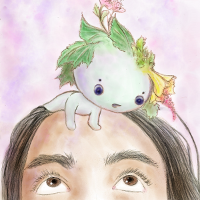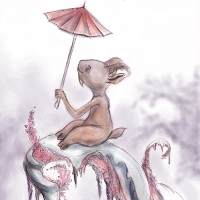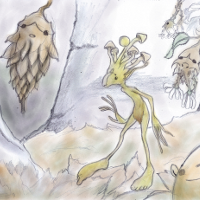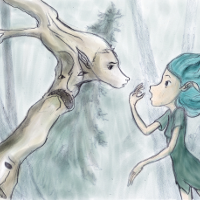 |
Information and stories on Japanese Gods
.
 |
|
Kami Fairy Tales Home Fairies Celtic Fairies Fairy Blog Finno-Baltic-Siberian Fairies Slavic Fairies
|
Japanese Fairy tales Oni Tengu Kitsune Tanuki  Taming the Kami of Earth Despite their importance people couldn’t live on mountains without taking some life, and large groups of people such as came over to Japan 2300 years ago could not live without farming. Thus we see a common theme that the land needed to be tamed, that the dangerous kami had to be taken in hand in order to make way for the villages. It’s important to bare in mind that all kami have four souls and three natures any one of which can dominate the kami’s actions (the fourth soul doesn’t provide a personality it just gives them their sacred/mystical aspect). At most times typical kami are in a state of Nigimitama, calm, tranquil, life giving. While in this state the kami causes nature to flow normally and isn’t overtly helpful or harmful. When their Sakimitama nature dominates a kami becomes very helpful, nurturing fields to flourish above normal, inspiring greatness, etc. The final nature Aramitama is the kami’s wild, feral and destructive aspect. It’s this nature that many of the kami appear to have been in when humans entered their realm. In one tale the people sought to turn a reed plain into rice paddies. However swarms of kami in the form of a serpent with horns, known as Yato-No-Kami, attacked them. These kami would attack and kill people, forcing the people to flee from them. When fleeing from a Yato-No-Kami any person who looked back at them would have their families slaughtered and would loose the ability to bare children and so they would die alone. Into this battle came a hero who began to slaughter the Yato-No-Kami. After driving them back the hero stuck a stick into the mountain side at the edge of the forest and called to the Yato-No-Kami: “We’ll give the land above this stick to you, as the domain of the kami. The land below, however, is the land of the humans and will be turned into rice paddies for the peoples use. To mark this truce I shall become the hafuri of the kami. We people shall revere and worship you from here on. So do not attack us any longer, do not bear a grudge against us. We see a similar story in the tale of Mt. Atago which was originally the home of a tribe of fierce some Tengu. To deal with this problem two sages were sent to protect what was then the city of Heian-Kyo (now Kyoto). These sages went up into the mountains and began to defeat the tengu. One of the most powerful to surrender to them was Tarobo. As part of the terms of his surrender Tarobo became the kami of Mt. Atago and cities guardian. He is a protector against fire as well and so he protects children from getting burned by the hearth. As time went on he began to look less and less like the tengu and has come to look a bit like Jizo (one of the seven lucky gods). What we see is that kami are often violent and often dangerous beings which only allow people to live on the land if they are defeated and or given offerings and supplication. Originally such supplication occurred at the boundary between the human and the kami lands. In this place humans would invite kami to feasts, to listen to songs and prayers of praise. In order to honor the kami in these places Yahiro were built as temporary shelters. There were likely no permanent shrines for a few hundred more years however. Shrines were built as homes for the kami, as places where priests and the people could worship and build a closer relationship with the kami. This is important because much of Japanese belief is based on relationships Excavations of sites have shown back that people have worshiped in these sites since prehistoric times, often before there was a shrine constructed there. In some folk tales such relationships weren’t always positive, however. In one tale two kami Chusan (a giant monkey) and Koya (a snake) demanded the sacrifice at their festival of a beautiful girl with white skin and long hair, which Chusan would eat at a feast. In this story a hunter passing through decides to help the girl who’s been chosen as the sacrifice so unknown to Chusan’s priests he gets in the wooden box which the offering is carried in with two of his dogs. The box is than carried in precession and placed before Chusan. The eight foot tall Chusan comes down with two hundred normal sized monkeys around him. He opens the box and the two dogs grab him and hold him down while the hunter begins to cut of his head. Chusan possesses one of his priests and pleads with the hunter for his life. The other priests also plead with him not to kill the kami. Eventually the hunter agrees to spare Chusan’s life if the monkey agrees not to kill anyone else ever again. |
|





